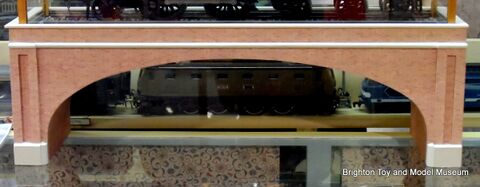Maidenhead Railway Bridge, span
| Exhibit |
|---|
Maidenhead Railway Bridge, span (i) (i)
|
 |
| location: |
A model of a single span of the GWR's Maidenhead Bridge, designed by Isambard Kingdom Brunel.
The brick bridge was designed by Brunel to take the Maidenhead to Twyford section of the line over the River Thames, and quickly became famous for having the longest-proportioned spans of any bridge ever built in brick, 128 feet wide and only 24.5 feet high. Brunel had been determined to keep the bridge long and flat so as not to upset the smooth gradient of the railway, and the river had a central shallow at the crossing-point that encouraged the use of only two arches.
Construction
Work started on the bridge in 1837, and the wooden supports below the arches were due to be removed in 1838, before it was noticed that the eastern arch appeared distorted, due to the contractor (Chadwick) having lowered the supports before the mortar had fully set. Worried GWR board members discussed modifying the design, but Brunel insisted that the bridge was sound and only needed the contractor to replace some of the surface work on the Eastern arch while the wooden supports were still in place, and this time to do the job properly. Arguments about the safety of the structure led to the decision to keep the wooden supports in place at least until 1840, but a nasty storm in autumn 1839 destroyed the wooden formers and blew them away, leaving the bridge unharmed, doubtless to the perplexion of critics who thought that the supports were stronger then the bridge, and doubtless to the immense satisfaction of Brunel.
The model
The span model was built in 2013 as a display stand for one of the museum's locomotives.
References
- E.T. MacDermot, C.R. Clinker, History of the Great Western Railway, Volume 1 1833-1863 (Ian Allan, 1964), pages 48-50, 53 ISBN 0711004110



